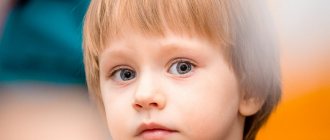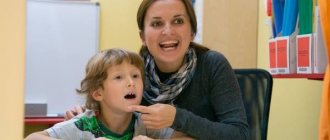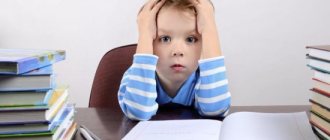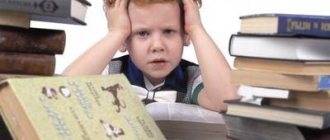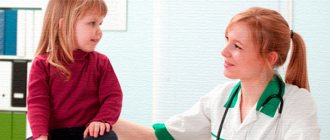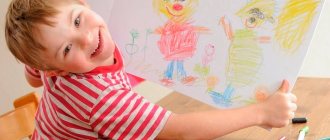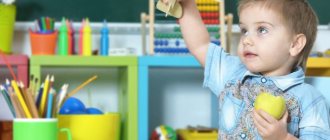- home
- Speech disorders
OHP level 2 is a clear violation of speech development in children with normal levels of intelligence and hearing, in which decreased abilities for verbal communication are observed.
The abbreviation OHP stands for general speech underdevelopment. The preschooler speaks in single words and short phrases, making a lot of grammatical errors. Common sentences are not present in speech, the active vocabulary is extremely poor. Simultaneously with violations of the lexical structure, disorders of phonemic hearing and articulation are observed.
Professor of the Research Institute of Defectology R. E. Levina dealt with issues of ONR. Based on her scientific works, correctional programs for children with speech pathologies are being developed today.
Causes
The characteristics of level 2 OHP indicate the polyetiological nature of the speech defect. That is, physical, biological and social prerequisites become the culprit for the development of the disorder. The main provoking factors are:
- fetal hypoxia;
- Rh conflict between mother and child;
- birth asphyxia;
- head injuries received at birth and in the first year of life;
- infections with neurotoxicosis;
- perinatal encephalopathy;
- pedagogical neglect;
- communication deficit;
- heredity
- separation from home, or hospitalism syndrome.
Often, OHP is a consequence of a complex of causes. This is important to consider when diagnosing and correcting a speech defect.
Symptoms
General speech underdevelopment of level 2 is characterized by the following symptoms:
- The child is diagnosed with ADD (age-related delay in speech development).
The first words appear by 2 years, the phrase after 3 years. By the age of 4, the baby constructs a sentence of 3-4 words, in most cases, without coordinating the grammatical forms of the lexemes with each other.
- Pronouns, prepositions, and conjunctions are rarely used.
- The accent is placed erroneously, most often on the last syllable.
- It is easier for a preschooler to list the names of objects and phenomena than to compose a text from these words.
- Numerous mistakes are made in the gender endings of verbs, nouns, and adjectives. The neuter gender is not perceived at all.
- When answering questions, the preschooler uses the initial forms of verbs and nouns in the nominative case.
- There are mixtures of numerical categories.
- Up to 4-5 years of age, a child with level 2 OHP helps himself with gestures and amorphous words.
- In complex words, the syllable structure is disrupted. The baby rearranges syllables and drops them. No word formation skills.
- Sound pronunciation defects in words. In this case, the isolated phoneme is pronounced clearly.
- In 70-80% of cases, kindergarteners with level 2 OHP have concomitant diseases: dysarthria, ADHD, mental retardation, paresis of articulatory muscles.
Numerous problems with extended speech lead to difficulties in understanding the baby’s statements. This can cause alienation, isolation, reluctance to take part in group games, or perform poetry at matinees in preschool educational institutions. That is, verbal, psycho-emotional contact with society is disrupted. Although there are no communication problems at home, parents understand the child’s speech and gestures.
Individual plan for correctional and developmental work. OHP level II, dysarthric component.
Individual plan for correctional and developmental work
2018 – 2021 academic year
Last name, first name: ……………………..
Date of Birth: …………………
L/Z: OHP
II in a child with a dysarthric component
in the first
year of study.
Work plan:
Non-speech activity.
1.Development of the psychological basis of speech:
a) promote the development of perceptions: visual, auditory, tactile;
b) promote the development of voluntary attention, memory, thinking;
c) promote the development of the emotional-volitional sphere.
2. Promote the development of gross and fine motor skills.
Speech activity.
1. Development of impressive speech:
a) develop an understanding of speech, the ability to listen to spoken speech, highlight the names of objects, actions, and some signs;
b) develop an understanding of the general meaning of the word;
c) teach to understand simple and complex instructions;
d) teach to understand prepositional relations between objects;
e) teach to understand the morphological characteristics of objects;
f) teach to understand logical-grammatical relations;
g) teach to understand small texts.
2. Development of expressive speech (development and facilitation of verbal communication, improvement of speech intelligibility):
a) creating motivation for speech communications;
b) develop active imitative activity: name one-, two-, three-syllable words;
c) formation of a dictionary: work on its quantitative and qualitative indicators;
d) formation of the syllabic structure of words;
e) development of prosody:
- development of the tempo-rhythmic aspect of speech,
- development of intonation expressiveness of speech;
f) formation of phrasal speech:
— learn to build simple sentences using the model: “Who? What is he doing? What?" on demonstration of actions and on questions;
- learn to extend sentences using homogeneous subjects and predicates;
- learn to combine words according to the laws of grammar;
g) correction of the phonetic side of speech:
- preparing the articulatory apparatus for pronouncing phonemes, strengthening the muscles of the articulation organs, developing the ability to master them;
— normalization of muscle tone of facial and articulatory muscles;
— conducting active articulatory gymnastics to achieve the full range of movements of the articulation organs, their precise coordinated work;
- elimination of salivation ( reproduction of chewing movements with the head slightly tilted back
);
— development of phonemic hearing, formation of skills of sound analysis and synthesis;
— correction of phonemes: [ы], [ц], [ч], [ш], [ш], [ж], [л], [рь], [х], [д], [т]
- setting of phonemes: [s], [s], [z], [z], [l], [r], [b], [n], [v]
— automation of phonemes: [s], [ts], [h], [sch], [sh], [zh], [l], [ry], [x], [d], [t], [s ], [с], [з], [зь], [л], [р], [b], [н], [в]
- differentiation of phonemes according to deafness-voicedness, hardness-softness
h) developing dialogue skills;
i) formation of monologue speech:
- memorizing short poems, stories, fairy tales;
- develop the skill of composing simple stories from two or three sentences (demonstration of actions, picture and question plan);
- retelling short stories, fairy tales;
3. Formation of prerequisites for learning to read and write.
Diagnostics
A comprehensive examination of a preschooler with speech disorders is carried out. Conclusions from a speech therapist, neurologist, and child psychiatrist will be required. The OHP diagnostic route consists of several stages:
- A conversation with parents to collect anamnesis and find out the possible cause of the speech defect.
- Assessing the level of development of a child’s speaking skills.
- Exclusion or confirmation of concomitant diseases, developmental delays.
- Studying the structure of the speech apparatus to detect organic disorders.
The final diagnosis is made based on the conclusion of the consultation. To send a child to a speech therapy kindergarten, it is necessary to undergo a PMPK. The commission must submit a reference for a preschooler from a preschool educational institution or from a psychologist. They will have a conversation with the child and parents and give recommendations on subsequent education. The program of individual work in accordance with the requirements of the Federal State Educational Standard will be drawn up by a teacher of the educational institution.
Treatment of OHP is a labor-intensive process. You cannot rely only on preschool teachers; be sure to do extra work at home, talk to your child more and listen to his statements.
Correction
When drawing up a plan for correctional work for type 2 ODD, the speech therapist breaks it down into several blocks:
- Development of the skill of understanding other people's speech
- Vocabulary expansion
- Composing words
- Development of phonemic hearing
- Developing the ability to compose simple and common sentences
- Development of the skill of coherent statements on free topics
It is impossible to overcome speech defects with type 2 OSD without medical help. It is necessary to include narrow specialists in the work: a neurologist, a pediatrician, a rehabilitation specialist, a psychologist. A preschool student should receive medication and emotional support.
Let us dwell on each stage of pedagogical work separately. The given examples of exercises and tasks can be used with children aged 3-4 years and older.
Understanding other people's speech and expanding vocabulary
The two stages of speech defect correction are inextricably linked with each other. The more the baby knows words and understands their meaning, the better he understands the meaning of what the interlocutor said.
The main goal of classes to develop communication skills is to establish contact between the student and the teacher (speech pathologist, speech therapist), and expand the preschooler’s passive vocabulary. You can realize your planned goals faster if you use visual examples and situations that the child can understand. Be sure to include facial expressions and gestures with your words.
There is no need to devote special time to developing the skill of understanding someone else's speech. Use any pretext to speak to your child: ask for help, bring something, comment on routine moments.
Here are some examples of such situations:
- Children going for a walk
The teacher turns to them and commands: “First we put on tights, then blouses...”. At first, you can show things and help with choosing an item from the box.
- Requests
“Bring the ball”, “Pick up the cube”. Gradually, the requests become narrower: “Take the blue book on the top shelf,” “Show me where the doll in the red dress sits.”
- Putting toys in their places
The bear will sit on the sofa, the bunny will lie in the crib, and the cubes will be on the table.
To distinguish word forms, use paired pictures:
- Singular and plural verbs, nouns
The fish swim - the fish swims.
- Verb tenses
Masha is eating soup, Masha will eat soup, Masha has eaten soup.
- Case forms of nouns
The baby puts on a fur coat. The fur coat hangs in the closet.
- Possessive pronouns, adjectives
My sock, daddy's sock. Here you can use requests: give me your pencil, give Mashin a pencil.
- Spatial concepts
They help to attract the use of prepositions. The ball lies on the table, under the table, near the table. Use requests: place a book on your lap, under a chair, by the bed.
Replenish your vocabulary with the help of speech therapy lotto on different topics: “Animals”, “Seasons”, “Fruits”, “Vegetables”, “Transport”. Learn not only the names of objects, but also the verbs associated with them.
For example, when discussing a topic about animals, ask your child: is it wild or domestic, what size is it, what color is it, what does it eat, etc.
Learning to form words
It is difficult for a preschooler with level 2 OHP to say words affectionately, that is, to add suffixes to them - enk-, -k-, -onok- and others. Let's do the following tasks:
- Big small.
Watermelon-watermelon, hare-rabbit.
- Add a prefix.
He ate, ate, said and told. It is important to pay attention to changes in the lexical meaning of the word.
Games in pairs are effective for learning the composition of a word. For example, children should “argue”: I have a nose - and I have a nose, I have a house - and I have a house. The competitive element adds a touch of fun to the work process.
Development of phonemic hearing
An important component of speech therapy work to eliminate defects in stress placement and sound pronunciation. At the initial stage, you need to show children the variety of sounds in nature: rustle paper, squeak, listen to the howl of the wind, birdsong, the sound of water. Seek help from musical instruments (drums, violin, metallophone). The child must distinguish and name not only the source of the sound, but also feel its volume and melody. Hand out cards with pictures of instruments, children try to depict what it sounds like.
The next stage is distinguishing speech sounds:
- What is the difference between the nouns mouth-cat, porridge-Masha?
The preschooler must name the sounds that do not match.
- Similar word forms.
I’ll beat you and I’ll give you a roll.
- Wrong echo.
The student must repeat the word after the teacher, changing 1-2 sounds. For example, I carry - I bake, daughter Masha - daughter Glasha.
Making proposals
Start your practice with simple phrases of 2 words: I came, I put on my fur coat, I like compote. Gradually teach your preschooler to compose sentences with 3 members. You can use the following type of tasks:
- What is he doing?
Print out pictures of children playing sports, walking or harvesting. The preschooler's task is to tell what he sees, but come up with several actions for one character. For example, Masha stands on the stairs and collects pears. Vanya, Katya, Vova are walking. It is important to select homogeneous predicates or subjects.
- What?
We select complements to the predicate from the picture. For example, the Boy draws (what?) a house, a mushroom, a hedgehog.
- I have.
Children are given objects (fruit, toys, books) 2-3 per hand. Everyone must tell what they have. “And I have a coloring book, pencils, paints. And I have a mouse, a doll and a mushroom.”
- Restore the correct word order.
The speech therapist pronounces a set of words: sculpts, mouse, Masha. The students should be able to: Masha sculpts a mouse.
- Detailed answers to questions.
What are you doing? What does mom like to do? What do you see outside the window?
I draw the sun, my mother loves to sing and dance, I see puddles and trees outside the window.
Be sure to spend time developing memory and attention. Use the games “Find the odd thing in the picture”, “Who can find the object faster” (hidden in a group or in the picture), “Find the mistake”. The last game is played like this:
- The teacher says a sentence and deliberately makes a grammatical error in it.
For example, Masha and Vanya were picking pears from a tree.
- Children must repeat the sentence and be able to find and correct the mistake.
When composing and pronouncing words and sentence phrases, pay attention to the emphasis and articulation of the student. Don’t be afraid to stop, correct, ask to pronounce the correct version.
We develop coherent speech, the ability to compose your own statement
Conduct classes on developing independent speech skills in the form of a friendly conversation. Offer students the following tasks:
- Describe the picture.
- What has changed outside the window?
- Who wore what today?
- Retelling the text you heard. You can ask leading questions and rely on illustrations.
- Restore the sequence from the pictures.
- Conjugate pronunciation.
Use stories in special moments. Children voice the process of dressing for the street: first I will put on my pants, then my boots, and tie my hat. At the same time, ask questions: what color are your socks? What kind of hat does Lena have (knitted, fur)? Do you have nice shoes?
For the first 3-4 months, it is recommended to conduct individual lessons, then children are grouped in groups of 2-3 people. When preschoolers make contact with a speech therapist and a speech pathologist and are not shy about speaking and answering questions, you can move on to mass games and frontal questioning. Reinforce interest in activities with praise, surprises, and games. The lesson should last no more than 15 minutes, since children with OHP are weakened and suffer from low performance.
Include dynamic breaks in your classes to relieve physical and emotional stress. This could be finger exercises, warming up the torso.
Balashova O.P. OHP correction program of the second and third levels
Currently, there is a tendency to improve the quality of education and upbringing. In mass educational institutions, medical, psychological and pedagogical examinations of children attending preschool and school educational institutions are organized. The causes of maladaptation of individual schoolchildren are identified in a timely manner, and consequently, the most effective ways to correct certain disorders are selected.
Based on the research of A.V. Yastrebova, L.F. Spirova, T.P. Bessonova and many others, we can confidently say that one of the common reasons for the failure of primary school students in secondary schools is various oral speech disorders, which often make it difficult to master correct reading and competent writing.
In this regard, a full examination and provision of assistance to a child experiencing speech disorders requires the participation of not only a speech therapist, but also other specialists (psychologist, psychiatrist, neurologist), which becomes possible on the basis of a specialized psychological, medical and pedagogical center.
The goal of the program: correction of general speech underdevelopment and prerequisites for the development of written speech disorders in preschool children.
Program objectives:
- Normalization of the activity of the articulatory apparatus.
- Formation of respiratory and vocal functions, prosodic aspects of speech.
- Work on pronunciation (production, automation, introduction to speech, differentiation of sounds)
- Formation of sound analysis and synthesis skills
- Enrichment of the dictionary.
- Formation of the grammatical structure of speech.
- Development of coherent speech.
- Formation of cognitive processes.
- Development of fine motor skills.
Addressee of the program: children with special needs aged 5-7 years.
Conceptuality of the program.
The program is based on the following principles:
- systematic;
- complexity;
- active;
- ontogenetic;
- general didactic (visuality, accessibility, individual approach, awareness).
Forms of speech therapy intervention – group and individual forms of work.
Speech therapy methods:
- Verbal;
- Visual;
- Practical.
Directions for program implementation
- Speech therapy diagnostics.
- Speech therapy correction of oral and prerequisites for the formation of written speech in children.
- Working with parents.
Forms of work with parents
- Individual consultations.
- Open individual and group speech therapy classes.
- Explanation of the peculiarities of doing homework.
Corrective work begins with a comprehensive psychological, medical and pedagogical examination of the child. After diagnosis, an individual correction program is developed for each child, which is implemented in the process of drug treatment, speech therapy, defectology classes and sessions with a psychologist.
The difficulty of correctional work with children within a specialized Center is that the frequency of appointments at the Center is 1-2 times a week, while daily group and individual classes are required. The program is designed for group lessons with children (2-4 people). Classes take place 1-2 times a week.
First year of study
Corrective work begins with the preparatory stage , which includes the development of cognitive processes, activation of the child’s passive vocabulary, and preparation of the articulatory apparatus for the formation of correct articulation of sounds of all groups in the process of performing articulatory gymnastics and articulatory massage. Duration – 2-10 lessons. During the same period, a course of speech therapy massage of the tongue of children with dysarthria is conducted. Individual and group classes are held 1-2 times a week.
Main stage
Correction of the phonetic-phonemic aspect of speech
Correction of sound pronunciation (normalization of the activity of the articulatory apparatus, production, automation and differentiation of sounds) is carried out according to an individual plan for speech therapy work with the child.
Each lesson includes the following sections:
| Chapter | Duration |
| Correction of sound pronunciation | 15 minutes |
| Formation of phonemic perception and skills of sound analysis and synthesis | 10 minutes |
| Development of fine motor skills | 5 minutes |
Sample Lesson Plans
| No. | Formation of phonemic perception and skills of sound analysis and synthesis | Development of fine motor skills |
| Development of auditory attention based on non-speech sounds | Finger gymnastics. Formation of skills in drawing straight lines. | |
| Development of auditory attention based on the material of speech sounds (syllable differentiation). | Finger gymnastics. Formation of skills in drawing curved lines | |
| Development of auditory attention based on the material of speech sounds (syllable differentiation). The concept of “word”, “sound”. | Finger gymnastics. Formation of skills in drawing broken lines. | |
| Sound U. Isolating the first vowel sound from a word. | Hatching. | |
| Sound A. Isolating the first vowel sound from a word. | Hatching. | |
| Sound I. Isolating the first vowel sound from a word. Sound analysis of combinations of two vowel sounds. | Hatching. | |
| Sound O. Sound analysis of combinations of three vowel sounds. | Hatching. | |
| Sounds A, O, U, I. | Hatching. | |
| Sound Y. Determining the last vowel sound in a word. | Graphic exercises. | |
| Determination of the first and last sound in a word. | Graphic exercises. | |
| Determining the presence or absence of sound in a word. | Graphic exercises. | |
| Sound M. The concept of “consonants”. Determination of the first consonant sound in a word. | Graphic exercises. | |
| Sounds M, M`. The concept of “hard” and “soft” consonants. | Graphic exercises. | |
| Sounds V, V`. Determination of the first consonant sound in a word. Analysis and synthesis of the reverse syllable. | Graphic exercises. | |
| Sounds V, V`. Determination of the first consonant sound in a word. Analysis and synthesis of the reverse syllable. | Graphic exercises. | |
| Sounds F, F`. Determination of the first consonant sound in a word. Analysis and synthesis of the reverse syllable. | Graphic exercises. | |
| Sounds V-F, V `-F `. The concepts of “voiced sound”, “dull sound”. Definition of a vowel in the middle of a word. | Graphic exercises. | |
| Sounds B, B`. Definition of a vowel in the middle of a word. | Graphic exercises. | |
| Sounds P, P`. Sound analysis of a straight syllable. | Graphic exercises. | |
| Sounds B-P, B `-P `. Determining the position of a sound in a word. | Graphic exercises. | |
| Sounds B-P, B`-P`. Determining the position of a sound in a word. | Graphic exercises. | |
| Sounds D-D`. Isolating two vowel sounds in a word. | Graphic exercises. | |
| Sounds T-T`. Sound analysis of a straight syllable. Determining the position of a sound in a word. | Graphic exercises. | |
| Sounds D-T, D `-T `. Determining the position of a sound in a word. | Graphic exercises. | |
| Sounds D-T, D`-T`. Determining the position of a sound in a word. | Graphic exercises. | |
| Sounds G-G`. Complete sound analysis of the word. | Graphic exercises. | |
| Sounds K-K`. Complete sound analysis of the word. | Graphic exercises. | |
| Sounds G-K, G`-K`. Complete sound analysis of the word. | ||
| Sounds X-X `. Complete sound analysis of the word. | Graphic exercises. | |
| Consolidation of the studied material. | Graphic exercises. | |
| Consolidation of the studied material. | Graphic exercises. | |
| Consolidation of the studied material. | Graphic exercises. |
Correction of lexical and grammatical aspects of speech and development of coherent speech
Each lesson includes the following sections:
| Chapter | Duration |
| Correction of sound pronunciation | 15 minutes |
| Formation of the lexical and grammatical structure of speech | 15 minutes |
Sample Lesson Plans
| No. | Lexical topic | Grammatical category | Month |
| "Autumn" | Formation of concepts about the subject and action | October | |
| "Vegetables" | Gender agreement between noun and adjective. | ||
| "Fruits" | The concept of "offer". Writing 3-word sentences. | ||
| "Mushrooms" | Agreement between noun and verb in number. | ||
| "Cloth" | Accusative case noun. in units h. | November | |
| "Shoes" | Genitive case noun in units h. without pretext | ||
| "Migratory birds" | Genitive case noun in units h. with the preposition U. | ||
| "Wild animals" | Agreement of the numerals “one”, “one” with nouns. | ||
| "Pets" | Agreement of the numerals “two”, “two” with nouns. | December | |
| "Winter" | Agreement of numerals with nouns | ||
| "Wintering Birds" | Agreement of numerals with nouns | ||
| "Poultry" | Prefix verbs | ||
| "Furniture" | Preposition ON | January | |
| "Fish" | Dative case noun in units h. | ||
| "Dishes" | Instrumental case noun. in units h. | ||
| "Transport" | Agreement of the pronouns “my”, “mine”, “mine” with the noun. | ||
| "Plants of the meadow and garden" | Preposition UNDER | February | |
| "Insects" | Prepositions ON, UNDER | ||
| "Toys" | Preposition B | ||
| "Military professions" | Relative adjectives | ||
| "Our dads' professions" | Relative adjectives | March | |
| "Professions of our mothers" | Prepositions K, OT | ||
| "Spring" | Retelling a story using flannelgraph. | ||
| Consolidation | Retelling a story using a series of story paintings | ||
| Consolidation | Compiling a story based on a series of plot paintings | April | |
| Consolidation | Retelling a story based on a plot picture. | ||
| Consolidation | Compiling a story based on a plot picture | ||
| Consolidation | Compiling a story based on a plot picture |
At the final stage , a speech therapy examination is carried out, based on the results of which recommendations are given to parents.
Second year of study
At the preparatory stage, the activity of the articulatory apparatus is normalized. It takes 2-3 lessons.
Main stage
Correction of the phonetic-phonemic aspect of speech
Each lesson includes the following sections:
| Chapter | Duration |
| Correction of sound pronunciation | 15 minutes |
| Formation of phonemic perception and skills of sound analysis and synthesis | 10 minutes |
| Development of fine motor skills | 5 minutes |
Sample Lesson Plans
| No. | Formation of phonemic perception and skills of sound analysis and synthesis | Reading and writing skills |
| Sound and letter A. Determining the position of the sound in a word. | Typing the letter A. | |
| Sound and letter U. Determining the position of the sound in a word. Determining the presence or absence of sound in a word. | Printing letters. | |
| Sound and letter O. Determining the position of the sound in a word. Analysis and synthesis of combinations of 2-3 vowel sounds. | Printing letters. | |
| Sound and letter M. Analysis and synthesis of the reverse syllable. | Printing letters and syllables. Reading syllables. | |
| Sound and letter S. Analysis and synthesis of the reverse syllable. | Printing letters and syllables. Reading syllables. | |
| Sound and letter X. Analysis and synthesis of a straight syllable. | Printing letters and syllables. Reading syllables. | |
| Sound and letter Ш. Analysis and synthesis of forward and reverse syllables. | Printing letters and syllables. Reading syllables. | |
| Differentiation of sounds and letters S-SH. Analysis and synthesis of forward and backward syllables. | Printing letters and syllables. Reading syllables. | |
| Sound and letter Y. Complete sound analysis of monosyllabic words. | Typing letters, syllables and words. Reading syllables and words. | |
| Sound and letter L. Complete sound analysis of monosyllabic words. | Typing letters, syllables and words. Reading syllables and words. | |
| Differentiation of sounds and letters R-L. Complete sound analysis of monosyllabic words. | Typing letters, syllables and words. Reading syllables and words. | |
| Sound and letter N. Complete sound analysis of monosyllabic words. | Typing letters, syllables and words. Reading syllables and words. | |
| Sound and letter K. Complete sound analysis of monosyllabic words. | Typing letters, syllables and words. Reading syllables and words. | |
| Sound and letter T. Complete sound analysis of monosyllabic words. | Typing letters, syllables and words. Reading syllables and words. | |
| Sound and letter Z. Differentiation of sounds and letters S-Z. | Typing letters, syllables and words. Reading syllables and words. | |
| Sound and letter Y. Complete sound analysis of a two-syllable word. | Typing letters, syllables and words. Reading syllables and words. | |
| Differentiation of sounds and letters R-Y. Complete sound analysis of one-syllable words and two-syllable words. | Typing letters, syllables and words. Reading syllables and words. | |
| Differentiation of sounds and letters L-Y. Complete sound analysis of one-syllable words and two-syllable words. | Typing letters, syllables and words. Reading syllables and words. | |
| Sound and letter G. Differentiation of sounds and letters G-K. Complete sound analysis of one-syllable words and two-syllable words. | Typing letters, syllables and words. Reading syllables and words. | |
| Sound and letter D. Differentiation of sounds and letters D-T. Complete sound analysis of one-syllable words and two-syllable words. | Typing letters, syllables and words. Reading syllables and words. | |
| Sound and letter B. Differentiation of sounds and letters B-P. Complete sound analysis of one-syllable words and two-syllable words. | Typing letters, syllables and words. Reading syllables and words. | |
| Sound and letter Zh. Differentiation of sounds and letters Zh-Sh. Complete sound analysis of one-syllable words and two-syllable words. | Typing letters, syllables and words. Reading syllables and words. | |
| Sound and letter E. Complete sound analysis of one-syllable words and two-syllable words. | Typing letters, syllables and words. Reading syllables and words. | |
| Letter b. Complete sound analysis of one-syllable words and two-syllable words. | Typing letters, syllables and words. Reading syllables and words. | |
| Letter Y. Complete sound analysis of one-syllable words and two-syllable words. | Typing letters, syllables and words. Reading syllables and words. | |
| Sound and letter Y. Complete sound analysis of one-syllable words and two-syllable words. | Typing letters, syllables and words. Reading syllables and words. | |
| Sound and letter E. Complete sound analysis of one-syllable words and two-syllable words. | Typing letters, syllables and words. Reading syllables and words. | |
| Sound and letter Ch. Complete sound analysis of one-syllable words and two-syllable words. | Typing letters, syllables and words. Reading syllables and words. | |
| Differentiation of sounds and letters CH-T`. Complete sound analysis of one-syllable words and two-syllable words. | Typing letters, syllables and words. Reading syllables and words. | |
| Letter E. Complete sound analysis of one-syllable words and two-syllable words. | Typing letters, syllables and words. Reading syllables and words. | |
| Sound and letter C. Differentiation of sounds and letters S-C. Complete sound analysis of one-syllable words and two-syllable words. | Typing letters, syllables and words. Reading syllables and words. | |
| Sound and letter F. Differentiation of sounds and letters V-F. Complete sound analysis of one-syllable words and two-syllable words. | Typing letters, syllables and words. Reading syllables and words. | |
| Sound and letter Shch. Differentiation of sounds and letters Ch-Shch. Complete sound analysis of one-syllable words and two-syllable words. | Typing letters, syllables and words. Reading syllables and words. | |
| Letter b. Complete sound analysis of one-syllable words and two-syllable words. | Typing letters, syllables and words. Reading syllables and words. |
Correction of lexical and grammatical aspects of speech and development of coherent speech
Each lesson includes the following sections:
| Chapter | Duration |
| Correction of sound pronunciation | 15 minutes |
| Formation of the lexical and grammatical structure of speech | 15 minutes |
Sample Lesson Plans
| No. | Lexical topic | Grammatical category | Month |
| "Autumn" | Formation of concepts about the subject and action. Gender agreement between noun and adjective. | October | |
| "Vegetables" | The concept of "offer". Writing 3-word sentences. | ||
| "Fruits" | Prepositional constructions of singular nouns | ||
| "Mushrooms" | Prepositional constructions of singular nouns | ||
| "Cloth" | Prepositional constructions of singular nouns | November | |
| "Shoes" | Agreement of the numerals “one”, “one”, “two”, “two” with nouns. | ||
| "Migratory birds" | Agreement of numerals with nouns. | ||
| "Wild animals" | Agreement of numerals with nouns | ||
| "Pets" | Possessive adjectives | December | |
| "Winter" | Possessive adjectives | ||
| "Wintering Birds" | Prepositions IN, ON, UNDER, FROM. | ||
| "Poultry" | Dative plural h. noun | ||
| "Furniture" | Relative adjectives | January | |
| "Fish" | Instrumental plural case noun | ||
| "Dishes" | Prepositional plural case h. noun | ||
| "Transport" | Prepositions K, OT | ||
| "Plants of the meadow and garden" | Genitive plural h. noun | February | |
| "Insects" | Preposition C (СО) | ||
| "Toys" | Compiling a sentence with the conjunction A | ||
| "Military professions" | Preposition software | ||
| "Our dads' professions" | Making a sentence with the conjunction BECAUSE. | March | |
| "Professions of our mothers" | Preposition FROM-UNDER | ||
| "Spring" | Preposition BECAUSE | ||
| Animals of Hot Countries | Preposition OVER | ||
| Animals of the North | Retelling a story using a series of story paintings | April | |
| Retelling a story based on a plot picture. | Compiling a story based on a series of plot paintings | ||
| Consolidation | Compiling a story based on a plot picture | ||
| Consolidation | Compiling a story based on a plot picture |
At the final stage, re-diagnosis is carried out. Based on the results of the speech therapy examination, recommendations are given to parents and the child’s future educational route is determined.
Bibliography:
- Volkova G.A. Methodology for psychological and speech therapy examination of children with speech disorders. Issues of differential diagnosis. – St. Petersburg, 2003.
- Zhukova N.S. Primer. – M., 2005.
- Zhukova N.S., Mastyukova E.M. Filicheva T.B. Speech therapy. Overcoming OHP in preschool children. – Ekaterinburg, 2003.
- Kashe G.A. Prevention of reading and writing disorders in children with pronunciation deficiencies. -1965.
- Levina R.E. General characteristics of speech underdevelopment in children and its impact on the acquisition of writing. – 1961.
- Lopatina L.V., Serebryakova N.V. Development of the lexical and grammatical aspect of speech in preschool children with an erased form of dysarthria. – In the book: Reader on speech therapy. / Edited by L.S. Volkova, V.I. Seliverstova. – M., 1997.
- Nishcheva N.V. System of correctional work in a speech therapy group for children with general speech underdevelopment. St. Petersburg, 2001.
- Overcoming the general underdevelopment of speech in preschool children. / Under the general editorship of T.V. Volosovets. – M., 2002.
- Tkachenko T.A. We learn to speak correctly. System for correcting general speech underdevelopment in 6-year-old children. – M., 2001.
- Tkachenko T.A. We learn to speak correctly. System for correcting general speech underdevelopment in children 5 years old. – M., 2001.
- Tkachenko T.A. Formation and development of coherent speech. – M., 2001.
- Tkachenko T.A. Formation of sound analysis and synthesis skills. Album for individual and group lessons with children 4-5 years old. – M., 2003.
- Filicheva T.B. General underdevelopment of speech in preschool children. – In the book: Fundamentals of speech therapy work with children. / Under the general editorship of G.V. Chirkina. – M., 2002.
